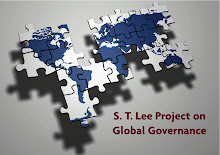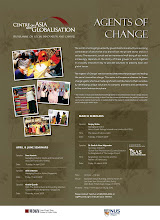 LKYSPP Professor Charles Adams spoke on the current financial turmoil at a panel dicussion held at the Asian Development Bank on 19 September. Here are his views on the crisis:
LKYSPP Professor Charles Adams spoke on the current financial turmoil at a panel dicussion held at the Asian Development Bank on 19 September. Here are his views on the crisis:The dynamics of the current financial crisis are broadly similar to many other crises. First, there is a period during which too much credit is extended, leverage rises to very high levels (in large measure through derivatives and low margins), and people start to believe that things will be different, based on a “story” of a new era (the Greed period).
This is the boom or bubble period that precedes the eventual collapse, as vividly documented by Kindleberger in his study of financial crises.
Second, there is some event (the “Canary in the coalmine” moment) that triggers a reappraisal of the story and, ultimately, a reversal of the excesses during the boom. The problems in the sub-prime segment of the US real estate market likely served as the wake up call during the current crisis.
In this second phase, positions are unwound, leverage is reduced, and financial firms begin to scramble for capital and liquidity in response to losses and writedowns (the Fear period).
Finally, following a series of ad hoc interventions involving lender of last resort and life-boat rescues, the official sector steps in with bold measure such as guarantees and the purchase of substantial chunks of the financial system and/or distressed assets.
For those with at least some familiarity with financial crises, the time signature of every crisis is uncannily similar. In the unhappy ending to many financial crises, the economy enters a deep and protracted downturn and public debt levels soar to high levels as the official sector bails out the private sector. The current crisis fits this mould. As the crisis is far from over, however, one should be careful in speculating about the end point.
The current crisis is only one of a large number of financial—and, particularly banking-- crises that have occurred in recent decades. The key wrinkles this time around are that the crisis blew up in the core rather than the periphery of the system (recall the large number of recent crises that occurred in emerging markets at the periphery of the system); has been affecting multiple markets, instruments, and institutions (commercial banks, investment banks, Insurance companies); and has spilled over across countries as financial risks were unbundled and sold around the world. Intriguingly, new financial players such as Sovereign Wealth Funds are starting to play a role as sources of new capital while hedge funds, at least thus far, have been in the back seat.
As in other crises, the current episode has involved a breakdown of the multiple lines of defence set up to deal with periods of excessive exuberance.
The first line of defence is the risk management of financial firms. Arguably, risk management across a range of firms has again been subject to massive failures, and their oversight oards have not performed as intended.
The second line of defence includes all the various market and official analysts-- as well as credit rating agencies--that monitored the US financial sector and failed to spot impending problems until too late. A conflict of interest on the part of rating agencies that advised on, and then rated, complex financial products likely played a role here, and will need (somehow) to be addressed. But it is also staggering how many other private and official observers did not predict problems, and did not call for action that could have avoided the excesses.
Finally, in the third line of defence, the very fragmented US regulatory bodies did not play their proper role and were arguably “asleep at the wheel” as the shadow banking system bloomed. Clearly, any one of these lines of defence could have prevented the crisis but each broke down, with serious consequences.










No comments:
Post a Comment